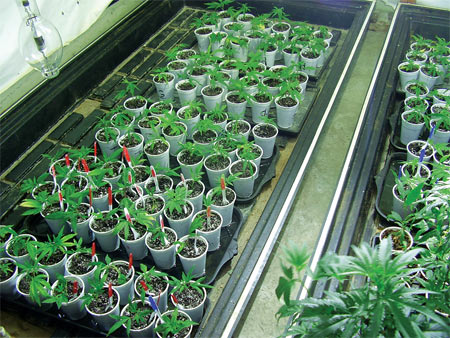
by Greg Green
Propagation
Propagation: 1 The action of breeding or multiplying by natural processes; procreation, generation, reproduction. 2 The action of spreading an idea, practice, etc., from place to place. 3 Increase in amount or extent; enlargement; extension in space or time.
Propagation is ‘The Grow’. However most people treat propagation as the actual events occurring between the planting of the seed and the transplant of that seedling to the main grow environment. Here we will treat propagation as the entire process of growing from seed to harvest. Propagation also includes the logistics of the grow.
So what are you going to do? Are you going to buy a batch of 10 seeds and grow them all in one go? Are you going to then kill the males and just smoke the females? Are you going to keep the males and produce more seeds from the females? How many seeds can a female plant produce? Should I plant my 10 seeds in one go? What should I do to guarantee that all my seeds will grow? These are the questions that you should be asking before you begin to grow and this is where propagation logistics comes into play. The answers depend largely on the size of your grow area and what your budget is.
Let’s say we have about $200/£180 to spend on seeds. We can buy an expensive strain like a G13 cross and then we can grow the G13 and produce more seeds from it. We can get anything between 100 and 2000 seeds depending on plant size and grow conditions. If we grow this season for 4 months and at the end produce a lot of seeds then we may never need to buy seeds for this strain again.
There is something else we can do called – CLONING.

This is a technique where by we can grow a number of plants and select a good female. Then we can take cuttings from that female mother plant and grow these cuttings into new plants. Clones always keep the same sex and vigour of the mother plant. It is also possible to create a garden of plants that will last for decades through cloning from a single female mother plant. Cloning is discussed in detail in a later chapter.
For the new grower it is advised that you buy 10 seeds and only germinate 3 the first time followed by another 3 the following week followed by the last 4 in two weeks after that. This will allow you some degree of experimentation as you may fail on your first attempt to germinate the seeds because of lack of any previous cannabis growing experience.
For people who have germinated seeds once before in the past, it is advised that you germinate 5 followed by another 5 the next week. If you are a long time grower with a good amount of growing experience then you can germinate all 10 in one go. Again you do not have to do it this way. It just helps reduce the risk of failing all the seeds because of bad germination methods.
During your plants growth you may decide that you want to pollinate ONLY ONE of your females. This means that you need to have two grow areas. One for growing all your female plants and another for growing a single or more females mixed in with some males. As we said before this depends on how much grow space you have and how much money you want to spend. It is important that your pollination room is kept well away from your female grow room. Pollen can travel by air and it is advised that the two areas are kept well apart. Also bees and other insects can spread pollen. Not only that but you can too. Always wash your hands and face after handling a male plant. This saves problems of pollen from a male plant getting onto a female that you wish to keep for sinsemilla.
So being logical we can see that we have paid a bit of money for 10 seeds and that we want to get 100% germination results. The following passages will tell you how to achieve that success rate.

